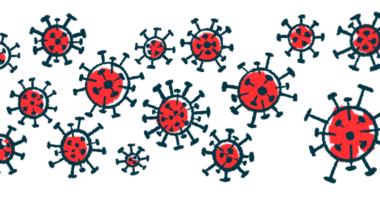Protein Linked to Inflammation May Be Promising New Treatment Target

A protein that triggers a form of cell death driven by inflammation is present at high levels in the skin of patients with scleroderma, and this suggests it may play a role in the development of the disease, according to a new study.
Researchers also observed that the skin of mice lacking the protein, called gasdermin D or GSDMD, grew less scar tissue and housed fewer immune cells than the skin of control (wild-type) mice when the mice were given bleomycin — a chemical that causes DNA to break, resulting in inflammation.
The findings may set the ground for using “GSDMD and its related molecules as potential therapeutic targets,” the researchers wrote.
The study, “Pyroptosis executor gasdermin D plays a key role in scleroderma and bleomycin-induced skin fibrosis,” which was conducted by a team of researchers in China, was published in the journal Cell Death Discovery.
Localized scleroderma is an autoimmune disease that makes the skin harden and tighten, which may cause pain and stiffness. Another type of scleroderma, called systemic scleroderma, also involves the internal organs. In both types, early inflammation appears to be dialed up.
Studies have shown that inflammasomes play a role in a number of autoimmune diseases, including scleroderma. An inflammasome is a complex of proteins inside a cell that can sense bacteria and other invaders or dangers. It works by making the cell release chemicals called cytokines that signal the need for the body to mount an inflammatory response. It also switches on GSDMD.
To be switched on, GSDMD needs one of its extremities to be trimmed away. Only then can it move to the cell’s border (membrane), where it forms pores and promotes the release of cell contents. This form of cell death, driven by inflammation, is called pyroptosis.
The researchers already knew that one inflammasome in particular, called NOD-like receptor family pyrin domain containing 3 (NLRP3), is present at high levels in skin lesions of patients with scleroderma, as are the cytokines it helps release.
Now, they focused their attention on GSDMD — and whether it is present and switched on in skin lesions of scleroderma patients. They used 15 samples of healthy skin versus 18 samples of skin lesions from patients.
First, they watched for differences in the levels of RNA — a molecule that serves as a blueprint of the gene that contains the instructions to make GSDMD. They found that the levels of RNA were higher in patients with scleroderma than in healthy individuals.
Next, the researchers looked for the trimmed (active) version of GSDMD in samples of skin tissue. Some of the patients with systemic scleroderma had active GSDMD in cells located around blood vessels. These patients had the disease for less time than those without active GSDMD, and most had early-stage lesions marked by redness or swelling.
To determine which type of cells had active GSDMD, the researchers looked at samples of skin lesions from six patients with localized scleroderma. They were able to map active GSDMD, as well as high levels of NLRP3, down to macrophages — a type of immune cell involved in inflammation.
“Macrophages can participate in tissue fibrosis [scarring] by secreting a variety of cytokines,” the researchers wrote.
Next, the researchers turned to an animal model in which fibrosis is induced by injecting bleomycin under the skin. For this experiment, they used mice lacking GSDMD. As controls, they used wild-type mice.
They found that the levels of GSDMD went up days after injection of bleomycin, as did the levels of two important cytokines — interleukin-1beta and interleukin-18. Moreover, active GSDMD was present in samples of skin from bleomycin-injected mice, but not in those from mice given a control (saline) solution.
In addition, when injected with bleomycin, mice lacking GSDMD grew less scar tissue than wild-type mice. Their skin was thinner and had fewer collagen-producing myofibroblasts and inflammatory cells such as macrophages.
The mice lacking GSDMD also had lower levels of interleukin-17A, a cytokine that is produced by helper T-cells — a type of immune cell that helps other cells of the immune system.
“GSDMD may promote the process of fibrosis by changing the immune response of Th17,” the researchers wrote. Th17 cells are a subset of T helper cells that are defined by their production of interleukin-17A.
“These findings provide the first demonstration that GSDMD related pyroptosis plays an important role in scleroderma,” they concluded.








